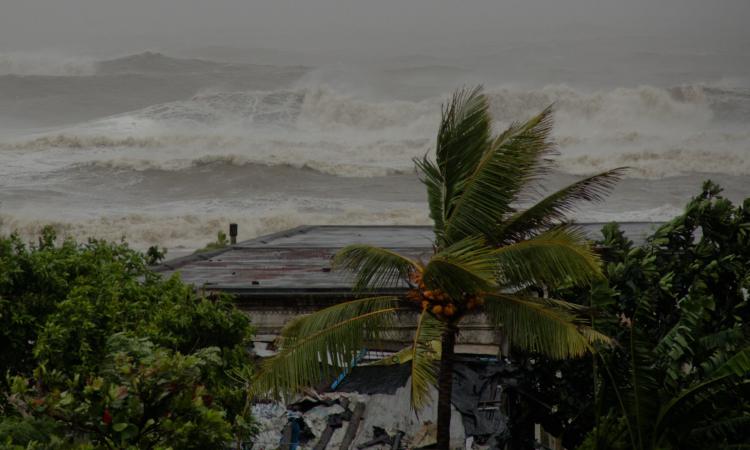
Tropical cyclones are intense circular storms that originate over tropical oceans and are among the most significant threats to human life and property in the world. Tropical cyclones are associated with heavy rainfall and strong winds, which cause hazards such as storm surges and inland flooding. The Indian subcontinent is adversely affected due to its long coastline exposed to most of the tropical cyclones originating in the north Indian Ocean.
Most of the tropical cyclones originate from over the Bay of Bengal, which affects the eastern coast of India. Despite having a smaller area compared to other tropical cyclone basins, the Bay of Bengal produces 5% of the world's tropical cyclones.
The shallow bathymetry and coastal terrain, and a high population density along the rim of the Bay of Bengal lead to devastating consequences. For instance, about 80% of the world's fatalities due to tropical cyclones are caused by tropical cyclones originating from the Bay of Bengal. Since the Bay of Bengal is surrounded by land, most of the tropical cyclones that originate here make landfall.
Landfalling tropical cyclones cause severe damage to infrastructure and economic losses in India. Extreme rainfall from tropical cyclones can lead to flooding, which disrupts the lives of people and their socio-economic well-being. Despite the severe hazards caused by tropical cyclones in India, their impacts on river basin-scale flooding are not well examined.
In this paper ‘On the causes of tropical cyclone driven floods in India’, published in the journal Weather and Climate Extremes, Volume 36, 2022, the authors use cyclone tracks from India Meteorological Department (IMD) and ERA5-Land reanalysis to identify the drivers of tropical cyclones induced floods in India. They select tropical cyclones that affected the Subarnarekha, Brahmani, Mahanadi, and Vamshadhara River basins during the 1981–2019 period.
The study estimated return periods of extreme daily and hourly rainfall and total runoff associated with tropical cyclones. The role of antecedent soil moisture on floods caused by tropical cyclones is examined. The results show that the distribution of extreme rainfall over a basin from tropical cyclones depend on the translation speed, track length, and size of the tropical cyclones. Severe flooding in the basins is strongly linked to antecedent soil moisture conditions.
Regardless of extreme rainfall, flooding due to tropical cyclones during the pre-monsoon (April–May) is less likely because of dry antecedent soil moisture conditions. On the other hand, tropical cyclones can lead to severe flooding during the summer monsoon (June–September) period due to relatively wetter antecedent conditions.
In the post-monsoon season (October–November), the severity of flooding caused by tropical cyclones is higher than the pre-monsoon season, and as we move further into the post-monsoon this severity reduces. The findings highlight the need to monitor the land-surface characteristics and tropical cyclones track prediction to identify the potential of flooding from landfalling tropical cyclones.
Based on the findings, the major conclusions of the paper are:
- In the Indian region, landfalling tropical cyclones do have the potential to cause floods in the river basins. Both tropical cyclone rainfall and antecedent soil moisture of the basin controls the severity of floods.
The landfalling tropical cyclones caused heavy mean daily rainfall accumulations over the regions with maximum return periods of 34, 33, 46 and 80 years in Subarnarekha, Brahmani, Mahanadi and Vamshadhara basin, respectively. Tropical cyclone rainfall depends on the translation speed and size of tropical cyclones, with slower and larger tropical cyclones causing higher rainfall accumulations.
- Landfalling tropical cyclones in the pre-monsoon season is less likely to cause severe flooding. The antecedent soil moisture in the basins will be very low during this period, and the rainfall from the tropical cyclones contributes primarily to the soil water content of the basin. During this period, the return period of daily runoff has relatively low return periods of 9, 4, 3 and 2 years in Subarnarekha, Brahmani, Mahanadi and Vamshadhara basin, respectively.
- Tropical cyclones can cause severe flooding during the monsoon period with return periods of 9, 44, 43 and 25 years in Subarnarekha, Brahmani, Mahanadi, and Vamshadhara basin. In this period, the high soil moisture conditions of the basin cause the tropical cyclone rainfall to be directly converted into runoff. The severity of flooding during this period primarily depends on the rainfall associated with the tropical cyclone.
In the post-monsoon period, the potential of flooding primarily depends on the antecedent soil moisture of the basin. When antecedent soil moisture is high, the likelihood of tropical cyclone induced flooding increases, particularly following the monsoon period or due to the clustering of tropical cyclones. Hence, in addition to tropical cyclone track prediction, to minimize damage from tropical cyclones, it is crucial to monitor the basin characteristics.
The full paper can be accessed here
/articles/what-causes-tropical-cyclone-driven-floods-india